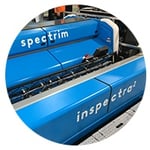
Simulators have been used in a variety of industries to help them prepare for every situation imaginable, or unimaginable for that matter. From surgical training in hospitals, to police and army academies - simulation tools are equipping professionals for everything and anything.
You are likely surprised to see the words “Simulation” and “produce packing” in the same sentence. What can this cutting-edge piece of technology deliver for the industry?
Let’s break it down - a simulator is the imitation of a real-world process or system that is designed to improve technical skills of trainees by offering a safe, risk-free training environment. Simulators are deployed in circumstances where conducting experiments on a real system is impractical because of costs, risks to the environment or personnel, or time involved.
The common threads here? Risk reduction, training, optimization. Read on to see how Compac’s new ‘Sizer Simulator’ addresses these opportunities.
Eliminate risk from training and optimization
Every line operator knows that any change made to a packing process leaves everyone covered in a sheen of sweaty anticipation. Will the next run go smoothly? Or will it leave fruit strewn about and packers standing idle as they wait for issues to be resolved?
A packhouse can be a stressful environment, so changing certain variables in attempt to improve efficiency is perceived as a risk and is often avoided. But these trials are essential to improving performance and are the perfect opportunity to use a Simulator.
A Simulator eliminates production risks which promotes engagement and deeper interaction with the software, making it an ideal environment for training and optimization.
Simulator as a training and continuous improvement tool
 Between the quality of fruit coming in, to the availability of labour on hand, and varying market demands for products, no two days are the same in your packhouse. Using a simulator to show you the outcome of a production batchallows you to better prepare for the effects of such variability.
Between the quality of fruit coming in, to the availability of labour on hand, and varying market demands for products, no two days are the same in your packhouse. Using a simulator to show you the outcome of a production batchallows you to better prepare for the effects of such variability.
Imagine being able to pre-emptively run a batch of fruit that you’ll need to pack the following week. Using the Compac Sizer Simulator, operators can predict the results of tomorrow’s packing schedule against measurable goals, such as cost per pack, packout per SKU and so forth. This allows the preparation of the right packing setup and labor allocation ahead of time.
Simulators for training
Packhouse staff are busy people and the increasing labour supply issues often result in added pressure to take on more tasks and responsibilities during the season. A simulator can ease this workload by giving teams an environment to trying new setups when there is no produce on-site. This allows staff to start planning with conclusive results during the off-season. It can also assist tremendously with on-boarding new staff before a season hits.
Compac’s Sizer Simulator will enable operators to feel empowered to get the most from the powerful software tools in front of them. Furthermore, Sizer Simulator will complement Compac’s training offerings. With a combination of on-site training during commissioning, operator trainer support, workshops in region and comprehensive user guides, operators can confidently engage with the software knowing there is an extensive support structure in place to help them learn, refresh and improve their capabilities.
Maximize the value of your pack
 Spectrim and InVision operators are supported by a different simulation tool – the Quality Trainer tool. The Quality Trainer offers the ability to test grade maps on fruit and optimize them to prepare for different grower’s produce or varieties before it comes onto the line. This allows the team to make any adjustments beforehand to ensure a quality pack and prevent expensive QC rework.
Spectrim and InVision operators are supported by a different simulation tool – the Quality Trainer tool. The Quality Trainer offers the ability to test grade maps on fruit and optimize them to prepare for different grower’s produce or varieties before it comes onto the line. This allows the team to make any adjustments beforehand to ensure a quality pack and prevent expensive QC rework.
Increasing packout using simulated results
Ensuring your produce makes it into the highest paying pack is a key focus for us and it is one of the differentiators that drives customers to invest in our technology. Traditionally, improvements to the sorting setup are only made after running a batch of fruit, meaning a large amount of produce is packed in a sub-optimal manner.
The Simulator gives clear insight into complex systems by providing measurable and comparable data to allow benchmarking. It becomes simple to compare different packing setups and identify a winning configuration which produces the highest desired pack output per capita of input fruit. It can also deliver initial startup savings, reduced training costs, reduced damage to equipment and improved packhouse uptime, and improved costs through better direct control of the packhouse processes.
In conclusion...
The Sizer Simulator is a fresh, never before seen addition to the Digitization and Automation trend that is currently sweeping the fresh produce packing industry.
Simulators and have been deployed in almost every best-of-breed company across a multitude of industries for improved training, ultimately increasing bottom line profits through fast paced experimentation and gathering evidence-based results in a risk-free environment.
The Sizer Simulator is a tool that works as an indicator of performance improvement, which provides confidence where previously there was uncertainty and doubt. If you can improve production capacity to 90%, why settle for 80%?
The Sizer Simulator brings value through providing a training environment which upskills packhouse staff and enables them to extract the full value from the powerful Sizer Software to increase yield, improve efficiency and maximize uptime of the packhouse equipment.
Click 'Find out more' to request an information pack on Sizer Simulator.



